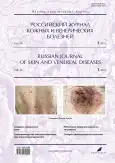Comparison of a single treatment with a Q-switched ruby laser and a Q-switched Nd:YAG neodymium laser for blue and black tattoo removal
- Authors: Pinson I.Y.1, Verchoglyad I.V.1, Kirilyuk T.I.1,2
-
Affiliations:
- Clinic of laser dermatology and cosmetology "Presidentmed"
- The First Sechenov Moscow State Medical University (Sechenov University)
- Issue: Vol 26, No 1 (2023)
- Pages: 79-85
- Section: COSMETOLOGY
- Submitted: 09.12.2022
- Accepted: 14.02.2023
- Published: 07.04.2023
- URL: https://rjsvd.com/1560-9588/article/view/114924
- DOI: https://doi.org/10.17816/dv114924
- ID: 114924
Cite item
Abstract
BACKGROUND: Black and blue tattoo pigment are the most commonly used colors and can be injected at different depths. The effectiveness of tattoo removal is related to the selected wavelength, type of laser, energy parameters, number of procedures performed. Q-switched (QS) ruby and neodymium (Nd:YAG) lasers are most effective in removing blue and black tattoos due to their high peak power and ability to break the pigment into small particles that are absorbed by the macrophage system. In the literature available to us, it was not possible to find data on comparative efficacy and adverse events in their application.
AIM: comparison of single treatment of blue and black tattoos with QS ruby laser (wavelength 694 nm) and neodymium Nd:YAG laser (wavelength 1064 nm).
MATERIALS AND METHODS: 35 patients with blue and black tattoos were included in our study. The tattoos were divided into two parts or two adjacent tattoos were used on the same part of the body with the same density and color of the tattoo pigment; one side was treated with a ruby laser and the other with a neodymium laser. The comparison took into account the instantaneous reaction, the result of processing and side effects. Statistical significance was set at a power level <0.05.
RESULTS: Edema and erythema were more common immediately after ruby laser treatment (power <0.05). The neodymium QS laser lightened tattoos better than the ruby QS laser after a single treatment (<0.05 power). There was no difference in side effects between the two types of lasers.
CONCLUSIONS: Neodymium Nd:YAG QS laser shows more efficiency and fewer procedures when removing blue and black tattoos. The instantaneous reaction after treatment with this type of laser is less pronounced than after the ruby laser.
Keywords
Full Text
About the authors
Igor Y. Pinson
Clinic of laser dermatology and cosmetology "Presidentmed"
Email: iddp@yandex.ru
ORCID iD: 0000-0001-8756-4172
SPIN-code: 7244-0086
MD, Dr. Sci. (Med.), Professor
Russian Federation, MoscowIrina V. Verchoglyad
Clinic of laser dermatology and cosmetology "Presidentmed"
Email: ons-10@yandex.ru
MD, Dr. Sci. (Med.)
Russian Federation, MoscowTat’yana I. Kirilyuk
Clinic of laser dermatology and cosmetology "Presidentmed"; The First Sechenov Moscow State Medical University (Sechenov University)
Author for correspondence.
Email: tatyana.kir.ch@bk.ru
ORCID iD: 0000-0002-2720-9942
SPIN-code: 2643-0387
MD
Russian Federation, Moscow; MoscowReferences
- Choudhary S, Elsaie ML, Leiva A, Nouri K. Lasers for tattoo removal: A review. Lasers Med Sci. 2010;25(5):619–627. doi: 10.1007/s10103-010-0800-2
- Bäumler W, Weiß KT. Laser assisted tattoo removal--State of the art and new developments. Photochem Photobiol Sci. 2019;18(2):349–358. doi: 10.1039/c8pp00416a
- Sardana K, Ranjan R, Ghunawat S. Optimising laser tattoo removal. J Cutan Aesthet Surg. 2015;8(1):16–24. doi: 10.4103/0974-2077.155068
- Grevelink JM, Duke D, van Leeuwen RL, et al. Laser treatment of tattoos in darkly pigmented patients: Efficacy and side effects. J Am Acad Dermatol. 1996;34(4):653–656. doi: 10.1016/s0190-9622(96)80068-5
- Husain Z, Alster TS. The role of lasers and intense pulsed light technology in dermatology. Clin Cosmet Investig Dermatol. 2016;9:29–40. doi: 10.2147/CCID.S69106
- Giulbudagian M, Schreiver I, Singh AV, et al. Safety of tattoos and permanent make-up: A regulatory view. Arch Toxicol. 2020;94(2):357–369. doi: 10.1007/s00204-020-02655-z
Supplementary files











